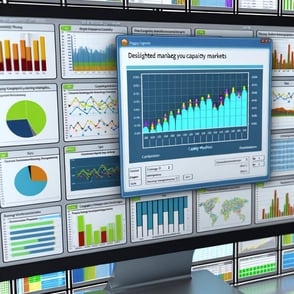Spot Markets
What are Spot Markets?
Spot markets are a cornerstone of the electricity sector, serving as platforms where electricity is bought and sold for immediate delivery. Unlike long-term contracts that lock in prices and quantities well in advance, spot markets reflect real-time supply and demand conditions, making them highly dynamic and essential for maintaining the balance between electricity supply and demand.
Spot markets in the electricity sector are short-term markets where electricity is traded for immediate or near-immediate delivery. These markets operate on various time frames.
In day-ahead markets, electricity prices are determined one day before the actual delivery. Market participants submit their bids and offers for electricity supply and demand, and the market clears based on these bids, setting prices for each hour of the following day. This provides a forecast and schedule for electricity generation and consumption.
Intraday markets allow trading of electricity closer to the time of delivery, enabling market participants to adjust their positions in response to unforeseen changes in supply and demand. There are two main types of intraday markets. Typically held once or multiple times throughout the day, intraday auctions set prices and trade volumes for electricity to be delivered within the same day. These auctions allow market participants to rebalance their portfolios with updated information after the day-ahead market has closed. Continuous intraday markets operate continuously, allowing participants to trade electricity in real-time, with transactions occurring up to a few minutes before delivery. Continuous trading provides flexibility for participants to respond to real-time changes in the grid, such as unexpected outages or fluctuations in renewable energy generation.
Together, these markets provide a comprehensive framework for managing electricity supply and demand on various time scales, ensuring that the grid remains stable and electricity is delivered reliably.
Price Determination
Electricity prices in spot markets are primarily determined by the balance of supply and demand at any given moment. The price-setting process typically follows a merit order system, where available power plants are ranked based on their marginal costs of production, from lowest to highest.
In both day-ahead and intraday markets, prices are set by matching bids from electricity generators (supply) with offers from consumers or utilities (demand). The highest-cost plant needed to meet the last unit of demand sets the market price, known as the marginal cost. In continuous intraday markets, prices are determined by the real-time interactions between buyers and sellers, reflecting the most current supply and demand conditions.
Spot market prices are inherently volatile due to the fluctuating nature of electricity demand and supply. Factors such as weather conditions, unexpected plant outages, and changes in fuel prices can cause significant price swings within short timeframes. For instance, during periods of high demand or low renewable generation, prices can spike as more expensive plants are brought online to meet demand.
In some cases, particularly during periods of low demand and high renewable generation, spot market prices can even turn negative. This occurs when there is an oversupply of electricity and grid operators must pay consumers or other grid participants to absorb the excess power to maintain grid stability.
Spot Markets in Grid Management
Spot markets are vital for the real-time management of the electricity grid. They provide a mechanism for grid operators to quickly respond to changes in electricity demand and supply, ensuring that the grid remains stable and that electricity is delivered reliably to consumers. The electricity grid must maintain a continuous balance between supply and demand. Spot markets enable this balance by providing a flexible platform where electricity can be traded as needed to address any imbalances that arise. Intraday and real-time markets are especially crucial in this regard, as they allow for adjustments based on near-real-time data. Spot markets also incentivize flexibility in the electricity system. For example, power plants that can quickly ramp up or down in response to market signals are highly valued in real-time and continuous intraday markets. Similarly, demand response programs, where consumers are paid to reduce their electricity usage during periods of high demand, are often integrated into spot markets to help balance the grid.
Economic and Environmental Implications
Spot markets have significant economic and environmental implications for the electricity sector. By reflecting real-time supply and demand conditions, spot markets ensure that electricity prices are aligned with the true cost of production. This leads to more efficient resource allocation, as higher prices signal the need for additional generation or reduced consumption, while lower prices indicate surplus supply. As the share of renewable energy in the grid increases, spot markets become even more important. Renewable energy sources like wind and solar are intermittent and can cause significant fluctuations in supply. Spot markets, particularly intraday and real-time, help to integrate these sources by allowing for rapid adjustments in electricity prices and dispatching resources that can compensate for variability in renewable generation. The volatility of spot market prices also encourages investment in technologies that enhance grid flexibility, such as energy storage, advanced grid management systems, and flexible generation resources. These investments are crucial for ensuring that the grid can accommodate increasing levels of renewable energy while maintaining reliability.
Conclusion
Looking forward, the role of spot markets is expected to grow as electricity systems become more decentralized and reliant on renewable energy. Advances in technology, such as real-time data analytics, blockchain, and artificial intelligence, are likely to enhance the efficiency and transparency of spot markets, making them even more integral to the operation of modern electricity grids.
Glossary
- Spot Market: A market where commodities, including electricity, are traded for immediate or near-immediate delivery, with prices reflecting real-time supply and demand conditions.
- Day-Ahead Market: A type of spot market where electricity prices are set one day before the actual delivery, based on forecasted supply and demand.
- Intraday Market: A market that allows for the trading of electricity closer to the time of delivery, enabling adjustments in response to real-time changes in supply and demand.
- Intraday Auction: A type of intraday market where electricity prices and volumes are set through scheduled auctions held throughout the day.
- Continuous Intraday Market: A market where electricity is traded continuously, allowing for near-real-time adjustments up to just before delivery.
- Real-Time Market: A market that operates very close to the time of electricity delivery, addressing discrepancies between forecasted and actual demand to maintain grid balance.
- Merit Order: A ranking of power plants based on their marginal costs of production, used to determine the order in which plants are dispatched to meet electricity demand.
- Negative Prices: A situation in spot markets where electricity prices fall below zero, typically due to oversupply and the need to maintain grid stability.
- Demand Response: Programs that incentivize consumers to reduce their electricity usage during periods of high demand, often integrated into spot markets to help balance supply and demand.
- Price Volatility: The degree of variation in electricity prices over a short period, driven by changes in supply and demand conditions.
.png?width=200&height=80&name=etpa-logo-color%20(1).png)











.png)
.png)
-1.png?width=250&height=100&name=etpa-logo-color%20(1)-1.png)